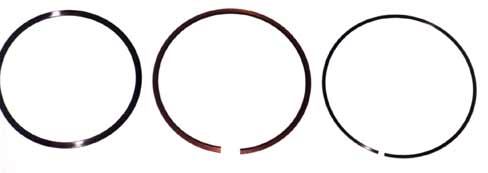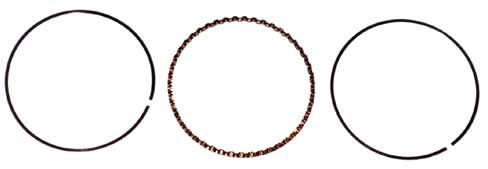| 
There’s more here
too: Total Seal uses a Gapless ring set that measures (for
example) 0.0469-inch thick. This ring package is then coupled
with a spacer of 0.031-inch, installed at the top of the groove
to take up the difference in a 5/64-inch groove.

 |
Part of
the Advantage system is this Gapless second ring. It differs
from others available in that the construction is very
simple. The primary second ring incorporates a ledge that
acts as a receiver for the smaller sealing ring. When
used in tandem, this second ring combination eliminates
the gap. The end result is a definitive lack of blow-by
coupled with increased levels (some times considerable)
of manifold vacuum. Note too, that a spacer is used in
conjunction with the second ring package. |
|
|
There is something you should be aware of when it comes to
Gapless rings: They’re either used in the top groove
or the second groove. Not both. And rings designed for the
top groove cannot be used in the second groove or vice versa.
One other point to consider is this: When switching to a Gapless
ring, there may be tendency for the PCV system to become seemingly
more efficient. What’s really happening is the ring
seal is causing the engine manifold vacuum to improve. You’ll
likely notice this phenomenon if you have a vacuum gauge installed
in your car.

While the oil ring used in the Total
Seal system first appears to be standard issue, there is an
important difference: Both the expander and the rails are
narrower than normal. This results in reduced friction, however
oil control isn’t sacrificed.
The oil ring used in the Advantage Ring System is called
a “Gold Power” ring (obviously, because the expander
is gold in color). It’s different than most conventional
oil rings, however. Gold Power rings do not fit as deep as
regular oil rings. This design is based upon narrower rails
and a narrow expander. The result is reduced friction, but
at the same time, the configuration maintains oil control.
The only catch with this type of ring is the installation.
Due to the narrow design, you have to be careful when installing
the piston in the bore. If you’re not paying attention,
the small rails may not stay in place. The bottom line here
is to watch the ring carefully as you push the piston through
a tapered ring compressor or when you squeeze the piston ring
combination with a band style compressor.
Does the new ring combination work? Most of the Stock Eliminator
racers we spoke with aren’t talking (and neither are
the Winston Cup teams which are using a similar arrangement).
But at least one Pro Stock engine builder is. They wish to
remain anonymous, but apparently the benefits of Total Seal’s
rings haven’t escaped them: A version designed for Pro
Stock is now used exclusively in their engines. The result
is the engines now make full power on the first dyno pulls
(instead of five, six or seven pulls later). Maintenance factors
have also improved markedly. In the end, there could very
well be something of interest to the little guy racer. Investigate
this stuff folks. You might be surprised at what you find.

|
